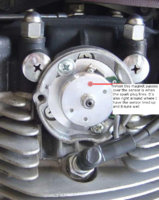franklin270h
XS650 Member
So I was firing up my 77 today. PAMCO ignition and e-advance. Initially when I went to fire it up, was struggling to get it going, had some pretty fierce kickback and backfire out of the carbs. Retarded the timing enough and got it to start, but was still extremely far advanced. On a timing light, PMA with Hugh's sticker to line up, fire mark is at ~6:00, was firing at nearly 9:00 way past the advance mark, that was at about 1500-2000 rpm (was struggling to get it to idle at that point just due to advance, had to hold the throttle some) and at that point was completely out of room on the plate cutout notches for adjustment. I shut it down just so I don't risk holing a piston.
I double checked TDC, which both pistons are at the top right on the mark, and camshaft locating pin is dead at 12:00 when at TDC, so I don't think it jumped a tooth or anything. Advance rod is stock one, locating pins in the same direction on both sides and i filed them to fit snugly into the channels for the rotor and advance replacement, they sit flush against the rod. Which with the e-advance I don't think you can be 180° out anyway given it has eliminated mechanical advance as a factor, but they are right regardless and pointing same direction. Cam chain tensioner and valve lash adjustments check out too. I also double checked the board mounting location on the pamco plate and it's right where it should be compared to all pictures I've seen, rotor also has all magnets in place and it is a 60° one. I unscrewed the e-advancer box and checked all solder joints and components and everything looks in order as well. It had points on it prior to and was fine on the timing, though I had the bike apart painting/restoring it so it has been a while since I've had an A/B comparison, I didn't do anything to the motor since then though.
I'm at a bit of a loss on it. Has anyone experienced anything similar to this?
I double checked TDC, which both pistons are at the top right on the mark, and camshaft locating pin is dead at 12:00 when at TDC, so I don't think it jumped a tooth or anything. Advance rod is stock one, locating pins in the same direction on both sides and i filed them to fit snugly into the channels for the rotor and advance replacement, they sit flush against the rod. Which with the e-advance I don't think you can be 180° out anyway given it has eliminated mechanical advance as a factor, but they are right regardless and pointing same direction. Cam chain tensioner and valve lash adjustments check out too. I also double checked the board mounting location on the pamco plate and it's right where it should be compared to all pictures I've seen, rotor also has all magnets in place and it is a 60° one. I unscrewed the e-advancer box and checked all solder joints and components and everything looks in order as well. It had points on it prior to and was fine on the timing, though I had the bike apart painting/restoring it so it has been a while since I've had an A/B comparison, I didn't do anything to the motor since then though.
I'm at a bit of a loss on it. Has anyone experienced anything similar to this?



